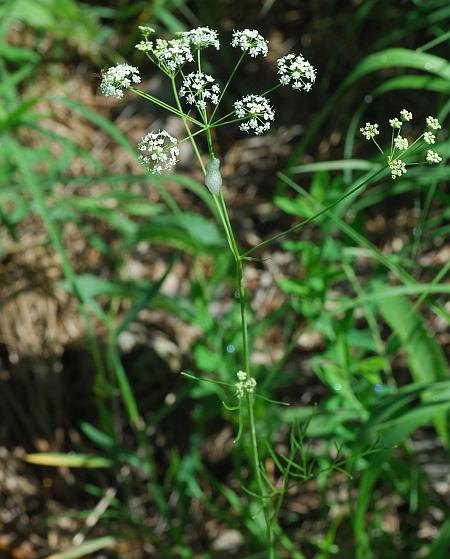Perideridia americana (Nutt.) Steud.
Eastern Yampah

Native
CC = 8
CW = 5
MOC = 23
SRank = S2
© SRTurner
Perideridia americana (Nutt.) Steud.Eastern Yampah | |
 |
Native CC = 8 CW = 5 MOC = 23 SRank = S2 |
© SRTurner |
|
Family - Apiaceae Habit - Perennial forb, glabrous, with clusters of mostly 2 or 3 tuberous-thickened roots. Stem - Erect or ascending, to 1.2 m, glabrous.
Leaves - Alternate and occasionally basal, mostly short-petiolate or nearly sessile upward, the sheathing bases not or only slightly inflated. Blades 3-15 cm long, narrowly oblong-ovate to ovate-triangular in outline, pinnately or ternately then pinnately 2-4 times compound or dissected, the leaflets or segments 5-50 mm long, linear to narrowly oblong, mostly narrowed at the base, the margins entire, narrowed to a sharp point at the tip, glabrous.
Inflorescence - Terminal and axillary, compound umbels, short- to long-stalked. Involucre absent or more commonly of 1-6 bracts, these 1-5 mm long, narrowly elliptic to narrowly triangular, usually shed by fruiting. Rays 6-20, 2-9 cm long. Involucel of 8-14 bractlets, these mostly shorter than the flower stalks, narrowly triangular to narrowly ovate. Flowers 15-25 in each umbellet, the stalks 3-10 mm long, elongated to 16 mm at fruiting.
Flowers - Sepals minute triangular scales. Petals broadly elliptic-obovate, shallowly notched or narrowed or tapered abruptly to a short, slender tip, white. Ovaries glabrous.
Fruits - Schizocarps 3-5 mm long, elliptic-ovate in outline, rounded at the base, flattened laterally, glabrous, brown to greenish brown, the mericarps narrowed along the commissures, with 5 slender and nervelike ribs, these hardly raised from the surface. Flowering - April - July. Habitat - Upland forests, glades, bluffs, upland prairies, usually on calcareous substrate. Origin - Native to the U.S. Lookalikes - Several other members of the Apiaceae, including species of Angelica, Levisticum, Ligusticum, Cicuta, and others. Other info. - This lanky species can be found scattered throughout portions of Missouri, most commonly in the southwest, and is apparently absent from the northwest and southeast regions of the state. Its wider distribution includes several states in the central Midwest, though it is uncommon in most places. In Missouri it is classified by the state as an S2 (imperiled) species. Even so, under favorable conditions populations can persist in an area for many decades. Photographs taken at Meramec State Park, Franklin County, MO, 5-30-2019, and at Gist Ranch Conservation Area, Texas County, MO, 6-9-2022 (SRTurner). |